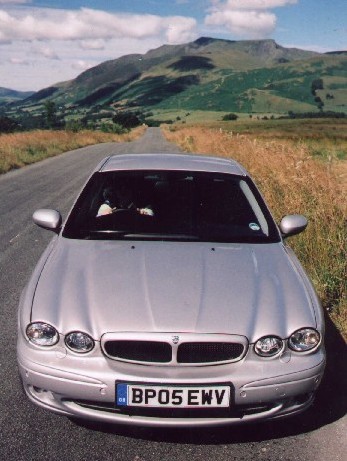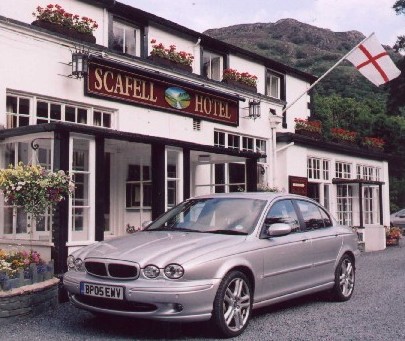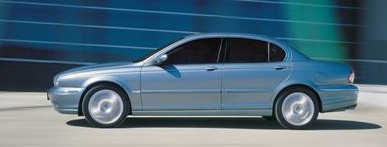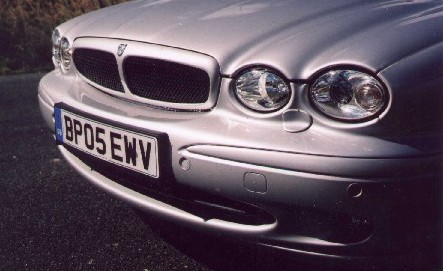(2005 model — UK)
Reviewed by Eddie Wren, September 2005
The Smallest ‘Cat’ is No Kitten!
Yet the X-Type Diesel is Stunningly Gentle on the Fuel Bill

Introduction
Almost fifty miles to the gallon.
Yes, it’s worth stating that again — fifty miles to the gallon!
“But it’s a diesel!” you protest as if that should suggest something brought in on the bottom of somebody’s shoe.
For those who haven’t noticed, however, many of the world’s top car makers have been ever more successfully refining diesel power over the past two decades, to the point where the perceived differences between petrol (gasoline) and diesel have now all but disappeared. And the economy of using diesel fuel speaks for itself.
In a recent screening of B.B.C. America’s version of the ‘Top Gear’ television program (on the Discovery Channel in the U.S.A.), Jeremy Clarkson managed — after several attempts — to lap the famous Nürburgring race track in Germany in an X-Type Diesel in less than ten minutes. Nine minutes fifty-nine seconds, to be precise. And that’s not bad considering his point that even Enzo Ferraris take eight minutes. But then somebody who perhaps should be called “The Lady of the Ring” — a young woman who gives the impression that she was born and raised on the track itself and who now coaches visiting drivers to lap faster — took the diesel ‘cat’ away from Jeremy and flung it round the circuit in an astonishing nine minutes twenty seconds.
So did I get to do my test drive of the X-Type Diesel at the Nürburgring?
Erm……. No such luck!

But I drove it around Northern England for two weeks — primarily in the excellent Lake District, where I was born and raised, and therefore intimately know the twisty, hilly roads.
And this Jag’ proved better than just ‘good,’ even on those demanding, enjoyable roads.
| Speaking of Jag’s, let me drag you a short way off topic for a moment, to make a plea to our many U.S. readers: Good people of America, as you undoubtedly know, this is a very British make of car so we are going to have to ask you to start pronouncing it correctly! It is a “Jag-you-are”, not a “Jag-wahhhr”! We Brit’s may have tolerated you throwing our cases of tea into Boston Harbour but if you insist on keeping this weird pronunciation we will have to re-colonize you and sort the matter out! {:-) |
One of the age-old, petty grievances about diesel engines is the warm-up period between turning on the ignition and starting the engine. Yet, in the X-Type, I found — admittedly due to my forgetfulness — that this lag has effectively disappeared. Instead, turning the key in one move almost always fired up the engine immediately.
The car has a claimed 0-60mph time of 9.5 seconds (which comes down to 6.6 seconds in the 3.0-liter petrol variant), yet moving off never felt laggardly. The acceleration from a standstill wasn’t precisely what keen drivers might be looking for, but once the engine reaches its ‘power band’ (the rev. range where lots of torque is available), that all changes in a heartbeat. And as Jeremy’s Nürburgring jaunt undeniably proves, the X-Type Diesel certainly has plenty of power once it is rolling.
A diesel that’s fun to drive? You’d better believe it.
And comfortable?…. Yes.
Stylish?……………… Yes.
Desirable?………….. Come on; this is a Jaguar, albeit the smallest. I would happily own one tomorrow (although an X.J.R.
could easily tempt me further up the ladder).

Copyright © 2005, Eddie Wren
And perhaps best of all, the claimed fuel economy proved almost as accurate as it was startling. Even though we spent much time on the twisting roads and mountain passes of the Lake District, we got median -forties in miles per gallon [mpg], and the car’s U.K. official ‘combined’ mpg is 49.
Our countless American readers should remember that a U.S. gallon is smaller than a British ‘imperial’ gallon, However, even so, if this Jag’ were available in the U.S.A., it would logically still get a ‘combined’ mpg slightly over 40, which is far better than almost all of the much smaller cars that are currently available in America. And in either country, this equates to over 600 miles on one diesel tank.
That should be viewed in another context, though, because given American dismay at the astronomical gasoline prices during 2005, perhaps it is time that perfect-lookingnestly looked towards diesel as ancient alternative to gas(online). Who in their right mind would currently reject fast, classy cars with such remarkable economies?
Naturally, the car is also available with a choice of petrol (gasoline) engines — 2.0, 2.5, and 3.0 liters, respectively — and may also be had as an estate car (station wagon).
Appearance
It doesn’t take a genius to see that both the X-Type and the slightly larger S-Type are ‘chips off the old block’ and are immediately identifiable as Jaguars even from some distance.

It is just as accurate to add that ever since at least the 1950s, the iconic Jaguar has been considered a perfect looking car.
Perhaps more than ever, the mere style has had to share priorities with fashion, but that can be said of several top marques, and Jaguars are now among the best.
Interior and Comfort

A very long journey in an X-Type would be no hardship.
The front seats were excellent, and the rear seats were very acceptable for all except very tall passengers,
There was also plenty of space surrounding the steering wheel (i.e., which rests, blocking the entire and ist movement of the driver’s arms if urgent steering was needed in an emergency).
Controls, Drivability, And Handling
The gear selection was crisp and accurate, and the very pronounced diesel power band made the gearbox fun. It should also be mentioned, that the car proved remarkably good for smooth, precise driving — a style that befits arriving anywhere in a Jag.
Considering this truly is the ‘budget’ end of the Jaguar spectrum, this car had astonishingly good balance and handling, so driving the X-Type is precisely what you don’t expect from a 2.0-liter diesel — fun!
On the car we tested, the only control, per se, that I didn’t like — and this is a common fault on many cars — is that activating the horn requires a driver to press the central boss of the steering wheel. Given that the very times a horn is most urgently needed are inevitably also the exact times when a driver should not have to remove a hand from the steering wheel’s rim, this ‘convenient’ positioning is undesirable. Horns should be operable using thumb-able buttons near the outer edge of each spoke of the steering wheel, but that is unpopular with car makers because that is where they like to fit audio controls, as it is easier to sell a car on its sound system and up-market (U.S.: ‘upscale’) trimmings than it is to do so purely on safety terms. And that’s a pity.
View Out
This is, of course, a vital yet often overlooked safety factor.
The necessity for modern cars to give good protection in the admittedly rare event of a saloon car (sedan) overturning means that the support system, especially the ‘A-pillars’ on either side of the windscreen, are now commonly much thicker than in years gone by. This blocks more of the driver’s view to either side, which can be particularly important when emerging from a side street, etc.
Until transparent or semi-transparent roof pillars become a reality (see our test drive of the Volvo Safety Concept Car), there is little that can be done except persuade drivers to look more carefully.
In this context, the X-Type provided a reasonably good all-around view.
Exterior Lights
As one would expect, the headlights were very capable and gave enough good illumination for twisty country roads at night.
As is now very common with cars of European origin, front, and rear fog lights were fitted.
[In the U.S.A., matched pairs ofhhigh-intensityred rear fog lights are illegal because they might be mistaken for brake lights. But, again, this is a case of politicians not knowing anything about genuine road safety. After all, which is better: the driver of a vehicle in thick fog seeing bright red lights that he thinks may be brake lights or not seeing any red lights until it is too late and having a collision?

Safety Aspects
This is, of course, the critical element in any car review that we do at Drive and Stay Alive, so — in no particular order — here goes:
Crumple zones are part of the front and rear structure of the vehicle, and anti-intrusion bars are built into all four doors. Though these are now features found in most modern vehicles, no car without such should ever be contemplated. To a large extent, these are the features that crash testing is designed to assess.
The X-Type has front, side (i.e., torso protection), and curtain (head protection) airbags fitted as standard. Our car also had an airbag to cushion the driver’s knees in a head-on collision.
Apart from the airbags, X-type safety features include dynamic stability control [D.S.C.] to help prevent wheel spin and skids, occupancy sensing to regulate the power of the front airbags, electronic brake-force distribution [EBD], anti-trap electrical windows, and front seatbelt pre-tensioners. Not all of these features are standard on all models, so we suggest anyone purchasing an X-Type check carefully to ensure all required systems fit the chosen model.
According to Euro NCAP (the European crash testing program), the X-Type has an adult occupant protection rating of four stars (five stars being the maximum possible) and a pedestrian protection rating of one star (three stars being the highest level currently achieved by other vehicles).
In the handbook, advice for setting the head restraints correctly was too sparse. For example, it read: “Adjust the head restraint so that it is just behind your head and never behind your neck.” But this information is inadequate given the number of people who have been hurt or even paralyzed by neck injuries to which an incorrectly set head restraint contributed. For safety guidelines on setting head restraints correctly, click here.
The final point about safety illustrates the different attitudes to highway safety in the U.S.A. compared to Europe. It is around 30 years since all dangerous, projecting objects, including the famous Jaguar ‘leaping cat’ bonnet mascot (U.S.: ‘hood ornament’), was banned from all vehicles sold in Europe because of the potentially deadly harm they could do to pedestrians
when collisions occur. In Britain, this was mandated under the ‘Construction and Use Regulations’ in the ‘Dangerous Parts and Accessories category.’ In America, however, where the per capita death rate is among the very worst for developed nations, potentially harmful mascots are still in everyday use — the Jaguar emblem is only one of a vast array of such ornaments.
Load Carrying and Towing (figures specific to 2.0-liter diesel saloon/sedan — for other variants, contact Jaguar)
Unladen weight (including 90% fuel and a 75kg driver) 1575kg 3472 pounds
Gross Vehicle Weight (G.V.W.) 1990kg 4387 pounds
Maximum weight for a braked trailer 1500kg 3306 pounds
Maximum weight for an unbraked trailer 746kg 1645 pounds
Roof load capacity (roof rack plus load, combined) 75kg 165 pounds
Technical Specifications
Overall length (saloon/sedan only) 4672mm 183.9 inches
Overall width, without mirrors, 1789mm 70.4 inches (add 8.4 inches for mirrors)
Wheelbase 2710mm 106.7 inches
Track – Rear 1522mm 60.5 inches (front 0.6 inches less)
Fuel Consumption (UK Market only)
Urban 7.7 lit/100km 36.6 mpg
Extra-Urban 4.6 lit/100km 61.4 mpg
Combined 5.7 lit/100km 49.1 mpg
Conclusion
Not only is the X-Type an enjoyable and precise car to drive, but also the diesel variant that we tested proved to be a stunningly economical option for such a relatively big saloon (though in the U.S.A. it would only be classed as a medium-sized sedan). It certainly passes the “I would have one” test.
Photographs (from Top):
1. 2005 Jaguar X-Type Diesel on the east side of Hardknott Pass, Cumbria, England — photograph by Eddie Wren;
2. The ‘old A66’ at Troutbeck with the mountain ‘Blencathra’ in the background (known locally as ‘Saddleback’ for
fairly visible reasons) — photograph by Eddie Wren;
3. Outside the Scafell Hotel, Rosthwaite, near Keswick — photograph by Eddie Wren;
4. Side view of an X-Type — photograph by Jaguar
5. Interior of an X-Type — photograph by Jaguar
6 Front of an X-Type — photograph by Eddie Wren;
